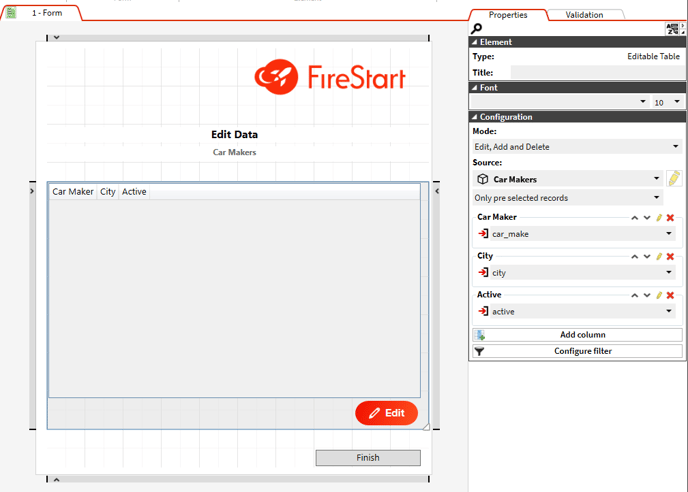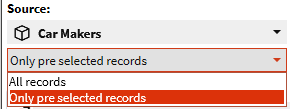The Editable table provides the ability to display an editable table listing the entries of a Business Entity in a FireStart Task form.
If the Business Entity is mapped to a third-party data source like SharePoint, CRM, SQL Tables etc., the records will be automatically updated there as well. Modified Business Entities are released to the Workflow for use in the following steps.
When opening the form designer in the FireStart Client, users can see the new Editable Table form control in the Element panel on the left side.
Configuration in the Form Designer
The control can be added to the form and configured at the Properties panel on the right.

Users can choose between three different Modes:
-
Edit
Count of the displayed data records does not change. Users can only edit the values of existing records -
Edit and Add
The table supports editing entries as well as creating new entries. Records that are newly created can also be removed as long as they are not submitted to the server (until the completion of the form) -
Edit, Add and Delete
Users have the permission to edit records, add new ones and delete any of the records

Similar to the already existing Selection Table control, a Source Business Entity can be chosen.
Two options are available showing what is shown in the table when the Task is sent to the User:
- All records of this Business entity, or
- Only pre-selected records currently chosen in the workflow.

The columns of the table can be defined depending on the fields of the source Business entity. The order in which the columns appear in the table can be chosen and the name of the column header can be changed. (If they do not customize the name, the column will get the name of the field of the source Business entity it is mapped to)
The icon on the left of the column configuration tells if the field is set to input (read only, can not be edited) or output (values in this column can be edited). Input/output settings can be changed in the Business entity settings dialog of the task.

Like with the Selection Table control, users can define Runtime Filter conditions for the editable table control as well: See screenshot below. A Runtime Filter filters all the records of a table to a subset that fulfills all the configured conditions. The conditions can compare values from a column of the table to static values or the current value of other Business Entities available in the form.
The bottom screenshot shows an example of a runtime filter that would only display records in the table where the value in the “city”-column is equal to “London”.

Client-side features of the form control
When a task form with an editable table control is rendered in the client during a running workflow, it may looks like the following screenshot. The list can be reordered by clicking the header of a column.

Clicking on a row of the table selects this row and enables the Edit and Delete buttons. The Delete button has to be activated with the mode chosen in the Form designer.

Clicking directly on a cell value of a column that is editable (the bound field is set to output) brings the cell into inline editing mode, where users are able to directly change the value in the cell.

If users click the Edit button, a popup form appears that lets them change the values of the currently selected row in full row editing mode. Columns bound to an attachment field can only be edited in this mode, because the file input control to change the attachments need more space than is available in inline editing mode.

The New button leads to a popup form that lets users create new records and add them to the table.

The currently selected row can be deleted by clicking the Delete button. A popup appears that will ask if the user is sure that the selected row should be deleted.

Multiselect table rows
Users are also able to select more than one row by holding Ctrl or Shift while clicking on multiple rows. Like in the windows file browser, holding Ctrl while clicking selects the individual clicked entries, holding Shift selects all entries from the last selected to currently clicked entry.

Selecting multiple rows gives users the ability to change values of all selected rows simultaneous when clicking the Edit button.

Multiselection makes it also possible to delete more than one row at the same time.


